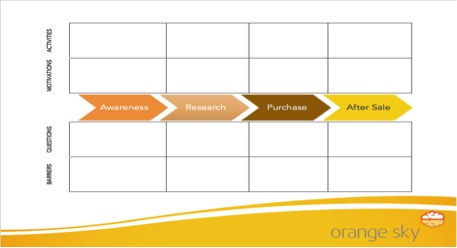The marketing discipline has seen a lot of changes in the past decades. Fundamentally, the role of the Chief Marketing Officer as originally intended within the organization hasn’t changed that much. What has changed in recent years is the increasing focus on the customer experience. An increasing number of corporate marketers are spending less time attracting new customers through advertising campaigns, and are instead investing resources and time into gaining a better understanding of the customer journey, and how to improve the customer experience.
This new customer experience focus has emerged from the realisation that:
- The customer is now our channel to market – customer advocacy has never been more important. More and more products and services rely on user ratings (Think Uber & AirBnB – services where both supplier and customers rate each other).
- Marketing isn’t just a branding exercise anymore – It’s not just about brand presence, and getting a message “out there”. Marketers are working diligently in getting customers to participate in creating the brand message. User-generated content (UGC) is leveraged by marketers to engage and influence not only direct customers, but also the customers’ circles of friends, and expanding reach, authenticity and credibility of message.
Those realisations have made marketers focus on storytelling and using user-generated content to help create the story of interaction with the brand. As the story involves the customer in various interactions with the brand, marketers can use the story to map out the journey of the customer. i.e. Building the customer experience map: from initial contact, through the process of engagement and into (hopefully!) a long-term relationship.
Mapping the customer journey and experience with the organisation often reveals the motivation of the customer and how they interact with the brand, the product or service. It gives an overarching picture of the customer moving through the funnel, from being completely oblivious to the brand’s existence, to becoming a loyal advocate. It helps identify gaps in the flow of the experience, where potential customers fall between the cracks, feeling ignored or irrelevant, or where the experience is disjointed or painful.
Most of all, a customer journey map puts the user front and centre in the organization’s thinking.
The map demonstrates the need for the entire organisation to adapt, change processes and procedures, and encourages people across various functions within the organisation to consider customer’s motivations, feelings and needs.
OK, I SEE THE NEED FOR MAPPING THE CUSTOMER JOURNEY. HOW DO I GO ABOUT IT?
Research
Get to know your audience. Donald Trump, as controversial and divisive as he may be, has proven over and over again that he knows his audience. He understands their fears, feelings, and what makes them happy, hopeful, sad and angry. Understanding people’s primal feelings, is a great start when mapping your customer journey.
Chances are you already have a lot of information about your customers. There’s no need to reinvent the wheel, and conduct more expensive surveys. Find existing data, dust it off, and have a fresh look into it lekarna-slovenija.com. If it’s recent enough, use it. If the data is a little dated, refresh it. Try two types of research: Analytics (Quantitative) and Anecdotal (Qualitative).
Analytical research
Understanding demographics and general preferences helps define who the main target market is, where they are, what they do, etc. However, this information is very general and shouldn’t be solely relied upon. With all due respect to internal and external analytics systems, the GIGO principal still applies — Garbage in, Garbage out. What you put in the system, ultimately will come out. Complementing existing numerical data, a well-constructed survey will provide valuable information about customer behaviour, wants and needs.
Anecdotal research
Raw data doesn’t tell the whole story, even if you think it helps you build a good case. To build a compelling case, you’d need to add human element – user’s stories, experiences, and anecdotes. A quick search on social media is likely to reveal some anecdotes from users, completely unprovoked. This will allow you to contact those people, and engage in a conversation with them, to dig deeper into their experiences.
Speaking to front-line staff who interact with customers daily, such as those in support and sales, is another useful way to understand customer needs.
It may also help to make some assumptions about their behaviour, based on your knowledge and experience with your customers. Then validate those assumptions using surveys, focus groups and even interviews with random customers. The magic number for those random interviews is six. Six interviews wouldn’t be “statistically significant”, but is likely to be enough to find patterns and validate / dismiss some assumptions.
THERE IS NO RIGHT OR WRONG WAY TO PRODUCE A CUSTOMER JOURNEY MAP
Customer Experience mapping can take any visual form you choose: it could be an Infographic, a storyboard or even a video. It’s up to you. But thinking of your audience when you present it.
It’s also open to personal interpretation how detailed or high-level you want to get in articulating the customer experience journey. As a guide, you should consider the following across each stage of the customer journey:
- Barriers
- Questions
- Motivations
- Activities
High level interaction points with your company will include (at least!) the following:
- Awareness
- Research
- Purchase
- Post Purchase (or in IT terms – OOBE (Out-of-Box Experience))
Using the above interaction points as an axis, you should drill down and add as many other interaction points which are relevant to your own customer, and company.
Ideally, the timeline isn’t linear, but circular (we want the customer to come back, don’t we?). For illustration purposes, I’ve used this process as a timeline, with a starting and ending points.
LET’S LOOK AT WHAT WE NEED TO CONSIDER
Actions
- What is the customer doing? Use only verbs here, with as detailed description as possible of the actions the customer is taking, to him/her to the next stage.
Motivation
- What is motivating the customer to move to the next phase?
- List any feelings or emotions they are feeling.
- Why do YOU think they should care enough to make progress in this journey?
Questions
- What can be unclear to the customer?
- Do we use industry jargon? Acronyms? Unclear language?
Barriers
- What obstacles can be perceived by the customers, which could prevent them from making progress?
- Is there any internal process which makes is difficult to move forward?
- Could cost (time, money, effort) be an issue?
If you had any exposure to user experience design, you’d know that in spite of our best intention, people are unpredictable, and wouldn’t necessarily follow our well-thought-off design. Some of our customers will skip a step in their experience. In addition, some marketers will find those steps too simplistic, and will add sub-steps to the process.
As I’ve mentioned before, there’s no right or wrong way to map the customer experience. As long you take the time to think about the various interaction points in your customer’s journey, and use your research findings to continuously improve on that experience, making the customer journey as short and enjoyable as possible, for everyone’s benefit!
originally published on Firebrand Talent blog.
[ssm_form id=’3277′]


